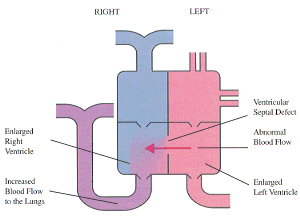
| Ventricular Septal Defect |
|
|
Down's Heart Group P.O. Box 4260 Dunstable, Beds, LU6 2ZT, United Kingdom Tel. & Fax: 0845 166 8061 E-mail: info@dhg.org.uk On-line community: http://groups.yahoo.com/group/Downs-Heart/ |
Reprinted with the permission of Penny Green, Director © 1998 Down's Heart Group UK Charity Nº 1011413 |

Diagram shows the heart looking from the front of the patient
The amount of blood flow from the left to right ventricle is dependent on the size of the hole and on the pressure difference between the ventricles. The higher the rate of flow, the more strain that is placed on the heart. The abnormal blood flow is responsible for the murmur that may be heard using a stethoscope.
Symptoms
Generally children with a small VSD will exhibit no symptoms (they are asymptomatic) and the problem may only be found when a murmur is detected upon routine examination. Children with a moderate VSD may breathe quickly, exhibit poor weight gain, be slow at feeding and prone to chest infections. This will be more pronounced where the hole is large.
Treatment
Children with moderate or large holes will require treatment with diuretics such as Frusemide and Spironolactone to control fluid retention and to reduce the volume of blood in the circulation, thus making the workload on the heart easier. Drugs such as Digoxin may be used in conjunction with these, to increase the contraction of the heart muscle.
Slow weight gain may lead to supplementation of the baby's milk with additives such as Calogen or Duocal. which increase the calorific intake. Severe feeding problems may necessitate feeding by way of a naso-gastric tube (through the nose and directly into the stomach), so that the baby does not use extra energy in obtaining nourishment.
Many VSD's will close spontaneously (naturally) or get much smaller, so it is normal practice to leave a child with a small or moderate VSD and monitor their progress before deciding to operate. Those holes that do not close will usually require surgery, indications for which may be continued failure to thrive despite medication, or concern about high pressure in the pulmonary artery - pulmonary hypertension (See Pulmonary Hypertension Topic Note).
In some babies with large VSD's, it is apparent that spontaneous closure is very unlikely due to the size and placement of the hole, and surgery will be recommended without delaying to see if the hole diminishes. If closure is unlikely, nothing is to be gained by waiting, and the aim is to limit damage to the lungs.
Follow Up Advice
All patients with a cardiac defect, whether repaired or not, will require antibiotic cover during any denial treatment to prevent bacteria entering the blood stream from where they can reach the heart causing bacterial endocarditis (infection ofthe heart lining), which can be very serious. If spontaneous closure occurs, your child's unit may advise that antibiotic cover can be discontinued one year after closure, but it is important that you check the advice with regard to your child as an individual.
"From the echocardiogram it was clear that he had a VSD, but they were 90% sure that surgery wouldn't be necessary. Monthly appointments were made to monitor the situation, and as far as I was aware all seemed OK, although his breathing was a little fast. You can imagine my shock when at one of these appointment's I was suddenly told that they recommended surgery within six weeks.... He is now almost eighteen months and doing very well, and you can really see the benefit of surgery. Before the operation he was very pale and puffed away like a steam train, now his breathing is normal, he is a healthy pink colour and is a lovely chubby little boy."
| Revised: December 19, 2005. |